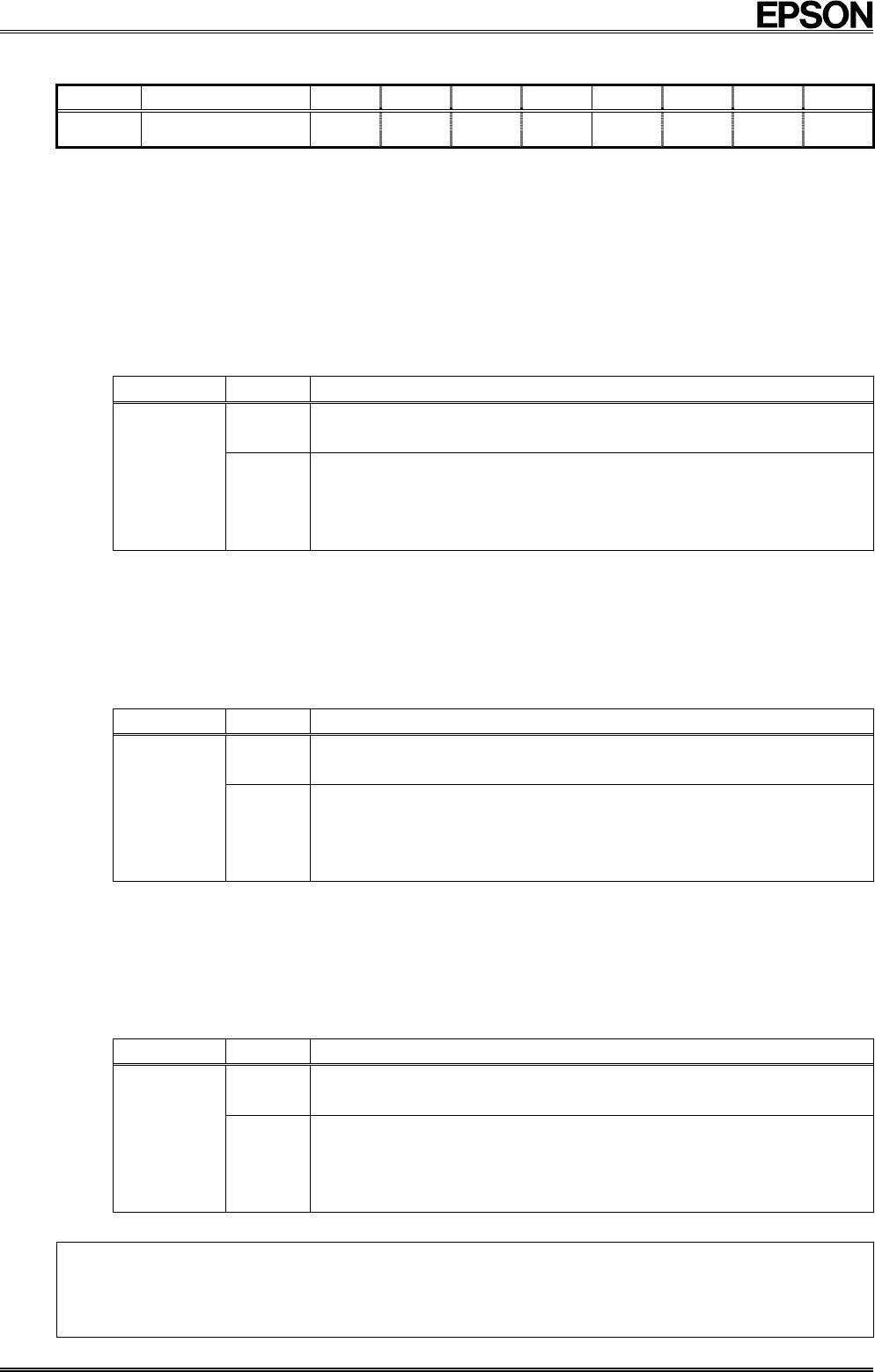
RX
-
8581
SA
/
JE
/
NB
Page - 7 MQ372-02
8.2.2. Control register (Reg F)
Address Function bit 7 bit 6 bit 5 bit 4 bit 3 bit 2 bit 1 bit 0
Control Register
!
!
UIE TIE AIE
!
STOP RESET
F
(Default) (0) (0)
(−) (−) (−)
(0)
(−) (−)
∗1)
The default value is the value that is read (or is set internally) after powering up from 0 V.
∗2)
"o" indicates write-protected bits. A zero is always read from these bits.
∗3)
"−" indicates no default value has been defined.
• This register is used to control interrupt event output from the /INT pin and the stop/start status of clock and
calendar operations.
1) UIE (Update Interrupt Enable) bit
When a time update interrupt event is generated (when the UF bit value changes from "0" to "1"), this bit's value
specifies if an interrupt signal is generated (/INT status changes from Hi-Z to low) or is not generated (/INT
status remains Hi-Z).
When a "1" is written to this bit, an interrupt signal is generated (/INT status changes from Hi-Z to low) when an
interrupt event is generated.
When a "0" is written to this bit, no interrupt signal is generated when an interrupt event occurs.
UIE
Data Function
0
When a time update interrupt event occurs, an interrupt signal is not
generated or is canceled (/INT status changes from low to Hi-Z).
Write/Read
1
When a time update interrupt event occurs, an interrupt signal is generated
(/INT status changes from Hi-Z to low).
∗
When a time update interrupt event occurs, low-level output from the /INT pin occurs only when
the value of the control register's UIE bit is "1". This /INT status is automatically cleared (/INT
status changes from low to Hi-Z) 7.8 ms after the interrupt occurs.
∗
For details, see "8.4. Time Update Interrupt Function".
2) TIE (Timer Interrupt Enable) bit
When a fixed-cycle timer interrupt event occurs (when the TF bit value changes from "0" to "1"), this bit's value
specifies if an interrupt signal is generated (/INT status changes from Hi-Z to low) or is not generated (/INT
status remains Hi-Z).
When a "1" is written to this bit, an interrupt signal is generated (/INT status changes from Hi-Z to low) when an
interrupt event is generated.
When a "0" is written to this bit, no interrupt signal is generated when an interrupt event occurs.
TIE
Data Function
0
When a fixed-cycle timer interrupt event occurs, an interrupt signal is not
generated or is canceled (/INT status changes from low to Hi-Z).
Write/Read
1
When a fixed-cycle timer interrupt event occurs, an interrupt signal is
generated (/INT status changes from Hi-Z to low).
*
When a fixed-cycle timer interrupt event has been generated low-level output from the /INT pin
occurs only when the value of the control register's TIE bit is "1". Up to 7.8 ms after the interrupt
occurs, the /INT status is automatically cleared (/INT status changes from low to Hi-Z)
.
∗
For details, see "8.3. Fixed-cycle Timer Interrupt Function".
3) AIE (Alarm Interrupt Enable) bit
When an alarm timer interrupt event occurs (when the AF bit value changes from "0" to "1"), this bit's value
specifies if an interrupt signal is generated (/INT status changes from Hi-Z to low) or is not generated (/INT
status remains Hi-Z).
When a "1" is written to this bit, an interrupt signal is generated (/INT status changes from Hi-Z to low) when an
interrupt event is generated.
When a "0" is written to this bit, no interrupt signal is generated when an interrupt event occurs.
AIE
Data Function
0
When an alarm interrupt event occurs, an interrupt signal is not generated
or is canceled (/INT status changes from low to Hi-Z).
Write/Read
1
When an alarm interrupt event occurs, an interrupt signal is generated
(/INT status changes from Hi-Z to low).
∗
When an alarm interrupt event has been generated low-level output from the /INT pin occurs
only when the value of the control register's AIE bit is "1". This setting is retained until the AF bit
value is cleared to zero. (No automatic cancellation)
∗
For details, see "8.5. Alarm Interrupt Function".
[Caution]
(1) The /INT pin is a shared interrupt output pin for three types of interrupts. It outputs the OR'ed result of these interrupt outputs.
When an interrupt has occurred (when the /INT pin is at low level), the UF, TF, read AF flags to determine which flag has a value of "1"
(this indicates which type of interrupt event has occurred).
(2) To keep the /INT pin from changing to low level, write "0" to the UIE, TIE, and AIE bits. To check whether an event has occurred without
outputting any interrupts via the /INT pin, use software to monitor the value of the UF, TF, and AF interrupt flags.


















